September 16, 2025
PHNOM PENH – An alliance of Cambodian civil society organisations and other specialists have found strong indications of the presence of toxic chemicals used during the Cambodia–Thailand border conflict, which now pose a serious threat to human health and the environment in border communities.
A rapid four-day assessment carried out jointly by eight organisations with provincial partners and stakeholders gathered consistent information regarding allegations of the use of toxic smoke/chemical substances and related symptoms during recent clashes along the Cambodia–Thailand border. These chemicals have heightened serious concerns about both short- and long-term impacts on local communities and the environment and require immediate and sustained responses, they said.
A statement on the preliminary findings of the rapid assessment highlighted that there are strong indications that toxic chemical substances were used in the conflict, and that they pose ongoing risks.
In addition, interviews with Cambodian soldiers and frontline villagers revealed that hazardous smoke was dispersed by aircraft and drones during clashes, even after the ceasefire agreement.
“They displayed symptoms including difficulty breathing, dry throat, weakness, headaches and signs of potential lung damage. Medical records obtained by the assessment team confirmed that some of these symptoms appeared in both soldiers and villagers,” the statement noted.
Furthermore, villagers living near battlefields along the Dangrek Mountains in Preah Vihear and Oddar Meanchey provinces — including Chheu Teal Kong village near Preah Vihear Temple, Thma Don, Hanuman and Taman villages near Ta Mone Thom Temple — reported mass deaths of livestock and poultry, with surviving pigs suffering from severe skin diseases.
Local farmers also observed that some crops and fruit trees had turned grey or red in colour and showed poor health.
Members of displaced communities from frontline areas near the Ta Krabey, T Mone and Preah Vihear temples expressed fears about returning home due to the presence of unexploded ordnance and toxic smoke. Many villagers reported that using rainwater stored in jars had caused vomiting, skin rashes and diarrhoea.
These claims have raised grave concerns about the possible contamination of local water sources, including ponds, lakes and streams in the affected villages and surrounding areas.
Such actions, the groups stressed, raise serious concerns under international law and humanitarian principles, including the Geneva Protocol, the Chemical Weapons Convention (CWC), international humanitarian law, human rights treaties, international environmental law banning transboundary hazards and the Paris Peace Agreements for Cambodia, which safeguard Cambodia’s sovereignty.
While the assessment team continues to gather more data and scientific clarification, they have called for urgent international and national priority action.
They strongly urged the UN, ASEAN, the international community and civil society groups — especially environmental and human rights organisations — to take immediate and active measures to halt what may be unlawful chemical smoke attacks, ensure civilian protection and uphold the ceasefire.
The organisations also appealed to the Cambodian government to conduct or continue investigations into the situation and provide emergency relief to affected communities, including safe drinking water, medical aid, environmental restoration and ensuring accountability under international law.
In addition, they stressed the need for in-depth, independent technical studies by the UN and ASEAN to assess the health and environmental impacts. Rigorous scientific investigation is needed to identify the substances used, confirm their origin, establish accountability and ensure justice under the framework of international law.
“Failure to act, or inaction, will mean failing to prevent grave human rights violations, threatening Cambodia’s sovereignty, and causing long-term environmental risks with cross-border impacts and misplaced global priorities,” they warned.
“Insufficient or inaction would amount to a failure to prevent serious human rights violations, endanger Cambodia’s sovereignty and trigger long-term environmental harm with cross-border implications, and set a terrible precedent for the world,” they added.
The civil society alliance includes CHRAC, NGO Forum on Cambodia, CLEC, FTUWKC and PADEK, along with a mix of environmental defenders, lawyers, advocates, human rights specialists, and social analysts. They carried out the rapid assessment in early September in key border areas of Preah Vihear, Oddar Meanchey and Banteay Meanchey provinces.


